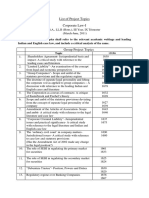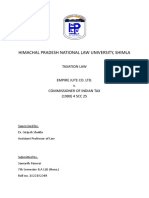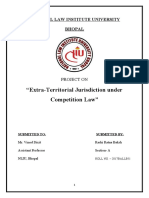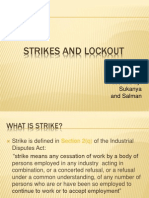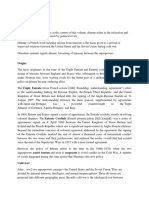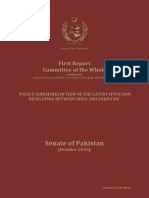World Trade Law - Project Topics
World Trade Law - Project Topics
Uploaded by
Salman AghaCopyright:
Available Formats
World Trade Law - Project Topics
World Trade Law - Project Topics
Uploaded by
Salman AghaOriginal Description:
Original Title
Copyright
Available Formats
Share this document
Did you find this document useful?
Is this content inappropriate?
Copyright:
Available Formats
World Trade Law - Project Topics
World Trade Law - Project Topics
Uploaded by
Salman AghaCopyright:
Available Formats
International Trade Law Essay/Project Topics 1. Is free trade necessary for economic growth? Discuss. 2.
. The World Trade Organization (WTO) epitomizes a free trade model. Discuss. 3. Most Favoured Nation (MFN) rule has ensured non discrimination amongst countries in the multilateral trading regime. Discuss. 4. What is the legal and economic justification for having the Most Favoured Nation (MFN) rule in the World Trade Organization (WTO)? 5. Can a jurisdictional conflict arise in situations where a country is a member of a Regional Trade Agreement (RTA) and the World Trade Organization (WTO) at the same time? 6. The India-EC GSP dispute gave a new interpretation to the Most Favoured Nation (MFN) rule. Discuss. 7. How significant is the concept of like product under the Most Favoured Nation (MFN) and National Treatment (NT) rule? Discuss. 8. Even after deciding a number of disputes the Appellate Body (AB) is still confused about the interpretation of like products in Article III of GATT. Discuss. 9. Has the growth of Regional Trade Agreements (RTAs) diluted the importance of the Most Favoured Nation (MFN) rule? Discuss. 10. The formation of Regional Trade Agreements (RTAs) under Article XXIV of General Agreement on Tariffs and Trade (GATT) has stifled the growth of the multilateral trade regime. Discuss. 11. The Generalised System of Preferences (GSP), as a legal principle, has hampered the uniform extension of the Most Favoured Nation (MFN) rule. Discuss. 12. The economic significance of the GSP programme outweighs the negative impact that it may have on the MFN rule. Discuss. 13. The Agreement on Trade Related Aspects of Intellectual Property Rights (TRIPS) is a result of forceful coercion of developed countries. Discuss. 14. The Agreement on Trade Related Aspects of Intellectual Property Rights (TRIPS) has become the global norm for IPR regulation. Discuss. 15. Allowing product patents on pharmaceuticals may lead to public health crisis. Discuss. 16. Article 30 of the TRIPS agreement can be used as an exception to the patent rule to cater to the public health needs of developing countries. Discuss. 17. There should be an agreement on trade and human rights in the World Trade Organization. Discuss. 18. An agreement on trade and human rights in the World Trade Organization (WTO) would become a smokescreen for protectionism. Discuss. 19. Article XX of GATT can be used to preserve non trade concerns. Discuss with specific reference to the Shrimp Turtle case. 20. The Doha declaration on TRIPS and public health has solved the public health problem of developing countries. Discuss. 21. Discuss Article XX of GATT as an exception to the National Treatment rule.
22. The Appellate Body has interpreted Article XX of GATT in a fashion that it cannot be used as a protectionist device for non trade concerns by an importing country. Discuss. 23. Industrial tariffs are important to boost industrialization. Discuss. 24. Dispute Settlement Body (DSB) of the WTO is a World Trade Court. Discuss. 25. Public international law has no influence over the functioning of the Dispute Settlement Body (DSB) of the WTO. Discuss. 26. Dispute Settlement Body (DSB) of the WTO is a marked improvement over the dispute settlement system under GATT. 27. Discuss the sequencing problem under the Dispute Settlement Body (DSB) of the WTO. 28. There is a conflict between the obligations imposed by the World Trade Organization (WTO) and the international human rights obligations. Discuss. 29. The World Trade Organization (WTO) needs to undergo many institutional reforms. Discuss. 30. There is no need to have an Agreement on Trade Related Investment Measures (TRIMS) to regulate imposition of performance requirements because such requirements are anyway caught by Article III of GATT. Discuss. 31. A Multilateral Agreement on Investment (MAI) under the World Trade Organization (WTO) will result in massive foreign direct investment in developing countries. Discuss. 32. The problem of compliance with the rulings of the Dispute Settlement Body has eroded the credibility of the WTO. Discuss. 33. The Dispute settlement provisions in the RTAs have resulted in a spaghetti bowl leading to jurisdictional problems vis--vis the Dispute Settlement Body (DSB) of the WTO. Discuss. 34. Compare and contrast the dispute settlement provisions in any two major RTAs with the Dispute Settlement Body (DSB) of the WTO. 35. Discuss the possibility of developing countries retaliating against developed countries in the WTO with specific reference to the EC-Bananas case. 36. Dispute Settlement Body of the WTO has only served the interests of developed countries in the WTO. Discuss. 37. The provision of compulsory licenses (CL) within the TRIPS agreement is an important flexibility to the patent rule despite its limitations. Discuss. 38. The December 2004 WTO decision goes a long way in addressing the concerns of countries that lack the manufacturing capability to issue Compulsory License for the production of generic medicines. Discuss. 39. A Multilateral Agreement on Investment (MAI) in the World Trade Organization would provide the best regulatory framework possible for the regulation of international investment. Discuss. 40. The World Trade Organization (WTO) does not adequately reflect the concerns of developing countries and hence needs to be revamped. Discuss.
You might also like
- RBA Negotiation Plan TemplateDocument1 pageRBA Negotiation Plan TemplaterafaNo ratings yet
- Profit Sharing Agreement Between Doctor and HospitalDocument2 pagesProfit Sharing Agreement Between Doctor and HospitalNitin Agarwal75% (4)
- My Dissertation On Impactof TRIPS Agreement On Trademarklawin IndiaDocument279 pagesMy Dissertation On Impactof TRIPS Agreement On Trademarklawin Indiasrvrushali84% (32)
- Gandhian Principles of Non-Violent Conflict ResolutionDocument15 pagesGandhian Principles of Non-Violent Conflict Resolutionkaran raja100% (1)
- Competition Law - Project TopicsDocument6 pagesCompetition Law - Project TopicsLalbee SNo ratings yet
- The Competition LawDocument59 pagesThe Competition Lawkarti_amNo ratings yet
- BA LL.B Project TopicsDocument3 pagesBA LL.B Project TopicsRajan100% (1)
- International Trade Law ProjectDocument15 pagesInternational Trade Law ProjectVishwaja Rao100% (3)
- International Trade Law Final VarunDocument15 pagesInternational Trade Law Final Varunvritaant varunNo ratings yet
- Insurance Law - Project TopicsDocument2 pagesInsurance Law - Project TopicsArpit GoyalNo ratings yet
- Case Study of Shamsher Kataria Case by Sivaganga.S.RDocument8 pagesCase Study of Shamsher Kataria Case by Sivaganga.S.RSiva Ganga SivaNo ratings yet
- Merger and Demerger of CompaniesDocument11 pagesMerger and Demerger of CompaniesSujan Ganesh100% (1)
- State of Bombay v. RMDCDocument1 pageState of Bombay v. RMDCshanika100% (1)
- Itl Project UjjawalDocument31 pagesItl Project UjjawalRaqesh Malviya100% (1)
- BALCO v. Kaiser International Case AnalysisDocument11 pagesBALCO v. Kaiser International Case AnalysisAditi JeraiNo ratings yet
- Parliamentarey History As An External Aid of InterpretationDocument6 pagesParliamentarey History As An External Aid of InterpretationVikarn SinghNo ratings yet
- S M Dugar - Guide To Competition Law (7th Ed)Document1,256 pagesS M Dugar - Guide To Competition Law (7th Ed)CHITRA PRAKASHNo ratings yet
- Topics For Seminar Course On International Commercial ArbitrationDocument2 pagesTopics For Seminar Course On International Commercial ArbitrationAman Singh50% (2)
- Corporate Law 1Document4 pagesCorporate Law 1sandeepNo ratings yet
- Subject: Insurance Law: PROJECT ON: Double Insurance & Re-Insurance - Indian PerspectiveDocument20 pagesSubject: Insurance Law: PROJECT ON: Double Insurance & Re-Insurance - Indian PerspectiveSachin PatelNo ratings yet
- Project Headings of CPCDocument4 pagesProject Headings of CPCIshan Dhengula75% (4)
- Tanya Chhabra (3591-9th Sem) - RenvoiDocument10 pagesTanya Chhabra (3591-9th Sem) - RenvoiTanuNo ratings yet
- Trade Law Reserach PaperDocument14 pagesTrade Law Reserach PaperRuchi sharmaNo ratings yet
- Empire Jute Co LTD V CITDocument12 pagesEmpire Jute Co LTD V CITSamarth PanwarNo ratings yet
- Nature and Scope of Private International LawDocument15 pagesNature and Scope of Private International Lawaditi todariaNo ratings yet
- International Law Notes GGSIPUDocument32 pagesInternational Law Notes GGSIPURishabh MalhotraNo ratings yet
- Labour Project TopicsDocument3 pagesLabour Project TopicsShenoy Prasad100% (1)
- Taxation Law Case SummariesDocument27 pagesTaxation Law Case SummariesRajeev Sutrakar100% (1)
- INTERPRETATION OF STATUTES Final Draft 4Document18 pagesINTERPRETATION OF STATUTES Final Draft 4Atulya Singh Chauhan100% (2)
- The Copyright (Amendment) Act, 2012Document8 pagesThe Copyright (Amendment) Act, 2012Shivam KumarNo ratings yet
- Project Topic: Forest Laws in India: A Critical Analysis 1. INTRODUCTION:-India Has Always Been Concerned With Its Green Resources and Thus ItDocument6 pagesProject Topic: Forest Laws in India: A Critical Analysis 1. INTRODUCTION:-India Has Always Been Concerned With Its Green Resources and Thus ItPriyesh Gaurav100% (1)
- A Critical Analysis of The Trade Mark Law in India With Special Reference To The Passing OffDocument21 pagesA Critical Analysis of The Trade Mark Law in India With Special Reference To The Passing Offalam amarNo ratings yet
- Law Mantra: Consumer Protection Visa Vis Insurance Sector in India: An Overviews of Challenges and NeedsDocument10 pagesLaw Mantra: Consumer Protection Visa Vis Insurance Sector in India: An Overviews of Challenges and NeedsLAW MANTRA63% (8)
- Consumer Online Foundation V Tata Sky LTDDocument5 pagesConsumer Online Foundation V Tata Sky LTDPritish Mishra100% (2)
- Mass Disaster and Environment Degradation.Document22 pagesMass Disaster and Environment Degradation.Mohsin Kabir50% (2)
- WTO Rules On FDIDocument24 pagesWTO Rules On FDIOnindya MitraNo ratings yet
- Adr ProjectDocument13 pagesAdr ProjectAnkit Singh100% (1)
- Management Prerogative During Pendency of ProceedingsDocument2 pagesManagement Prerogative During Pendency of ProceedingsJapneet Kaur100% (1)
- Shri Shamsher Kataria VDocument13 pagesShri Shamsher Kataria VAishwarya SudhirNo ratings yet
- A Project Report ON Arbitration Act - 1996: Submitted To: Submitted byDocument24 pagesA Project Report ON Arbitration Act - 1996: Submitted To: Submitted byAjay JoshiNo ratings yet
- Anti-Dumping Duties: An Assignment OnDocument24 pagesAnti-Dumping Duties: An Assignment OnAshish pariharNo ratings yet
- DR. RAM Manohar Lohiya National LAW University, LucknowDocument13 pagesDR. RAM Manohar Lohiya National LAW University, Lucknowjayati12345No ratings yet
- Indian Council of Legal Aid &Document18 pagesIndian Council of Legal Aid &Arun Vignesh67% (3)
- Interpretation of StatutesDocument19 pagesInterpretation of StatutesKumar AnkitNo ratings yet
- Case Analysis R.D. UpadhyayDocument5 pagesCase Analysis R.D. UpadhyayKanhaiya SinghalNo ratings yet
- International Trade LawDocument21 pagesInternational Trade Lawudita goel100% (1)
- Tax Law AssignmentDocument18 pagesTax Law AssignmentAditya Pandey100% (1)
- D - R M L N L U, L: Indian Tax Structure and Tax Reforms With GSTDocument17 pagesD - R M L N L U, L: Indian Tax Structure and Tax Reforms With GSThardik anandNo ratings yet
- Project TopicsDocument4 pagesProject TopicsAkshay SarjanNo ratings yet
- Francis Coralie Mullin V The Administrator, UnionDocument14 pagesFrancis Coralie Mullin V The Administrator, Unionshivam sharmaNo ratings yet
- Exclusion of Foreign Revenue LawsDocument4 pagesExclusion of Foreign Revenue LawsDishaniNo ratings yet
- Syndicate of The Press of The University of Cambridge v. B. D. Bhandari &anr., 185 (2011) DLT 346.Document5 pagesSyndicate of The Press of The University of Cambridge v. B. D. Bhandari &anr., 185 (2011) DLT 346.sharma kushaNo ratings yet
- Adr Final ProjectDocument34 pagesAdr Final Projectpraharshitha100% (1)
- NTPC v. Singer CompanyDocument3 pagesNTPC v. Singer CompanyAbhishek DeswalNo ratings yet
- LLM - Competition Law: Unit 1-Competition Act: Historical BackgroundDocument55 pagesLLM - Competition Law: Unit 1-Competition Act: Historical BackgroundMudit MaheshwariNo ratings yet
- Assignment & Licensing of Trademarks in IndiaDocument16 pagesAssignment & Licensing of Trademarks in IndiaHarsh Gupta100% (1)
- Abilasha Singh - Analysis of Jodhamal Kutiyal and CIT V Poddar CementDocument12 pagesAbilasha Singh - Analysis of Jodhamal Kutiyal and CIT V Poddar Cementabhilasha singh100% (1)
- "Extra-Territorial Jurisdiction Under Competition Law": National Law Institute University BhopalDocument25 pages"Extra-Territorial Jurisdiction Under Competition Law": National Law Institute University Bhopalrashi bakshNo ratings yet
- State of Bom CaseDocument12 pagesState of Bom CaseYoussef Hazem100% (1)
- Anti Competitive AgreementsDocument7 pagesAnti Competitive AgreementsfarazNo ratings yet
- CCI V SAILDocument6 pagesCCI V SAILVivek SinghNo ratings yet
- 7) Who Wrote Globalisation and Its Discontents'Document3 pages7) Who Wrote Globalisation and Its Discontents'pradeep punuruNo ratings yet
- 20.3 World Trade Organization (Wto) and Trade AgreementsDocument5 pages20.3 World Trade Organization (Wto) and Trade AgreementsSnipe XNo ratings yet
- Section 498A I.P.C ArticleDocument15 pagesSection 498A I.P.C ArticleSalman AghaNo ratings yet
- Some Hidden Facts About The Nehru-Gandhi Dynasty: N D A Y, M A Y 3 1, 2 0 1 0Document14 pagesSome Hidden Facts About The Nehru-Gandhi Dynasty: N D A Y, M A Y 3 1, 2 0 1 0Salman Agha100% (1)
- Balance of Payments: Presented By: AnuradhaDocument13 pagesBalance of Payments: Presented By: AnuradhaSalman AghaNo ratings yet
- Burra Kur Coal Co. Ltd. Vs Azimuddin Ashraff and Anr. On 14 January, 1960Document5 pagesBurra Kur Coal Co. Ltd. Vs Azimuddin Ashraff and Anr. On 14 January, 1960Salman AghaNo ratings yet
- Annexure: World Journal of Gastrointestinal OncologyDocument1 pageAnnexure: World Journal of Gastrointestinal OncologySalman AghaNo ratings yet
- Public Prosecution in IndiaDocument10 pagesPublic Prosecution in IndiaSalman AghaNo ratings yet
- Appasaheb Peerappa Chandgade vs. Devendra Peerappa Chandgade and Ors. (19.10Document7 pagesAppasaheb Peerappa Chandgade vs. Devendra Peerappa Chandgade and Ors. (19.10Salman AghaNo ratings yet
- Big BazarDocument87 pagesBig BazarSalman AghaNo ratings yet
- Discuss The Sequencing Problem Under The Dispute Settlement Body 2010Document9 pagesDiscuss The Sequencing Problem Under The Dispute Settlement Body 2010Salman AghaNo ratings yet
- A Project On Store Operation of Big BazaarDocument25 pagesA Project On Store Operation of Big BazaarSalman AghaNo ratings yet
- The Sirsilk Ltd. and Ors. vs. Government of Andhra Pradesh and Anr.Document7 pagesThe Sirsilk Ltd. and Ors. vs. Government of Andhra Pradesh and Anr.Salman AghaNo ratings yet
- GregoryDocument9 pagesGregorySalman AghaNo ratings yet
- Strikes and Lockout: Presented By: Sukanya and SalmanDocument22 pagesStrikes and Lockout: Presented By: Sukanya and SalmanSalman Agha100% (1)
- CMLR Dougan Treaty of LisbonDocument88 pagesCMLR Dougan Treaty of LisbonAncaPaduraruNiculescu100% (1)
- International Law Notes (Revised)Document178 pagesInternational Law Notes (Revised)AwaisAhmad100% (2)
- Indian History pt.8Document3 pagesIndian History pt.8A Parel DrNo ratings yet
- Law 12Document1 pageLaw 12Cyrille Keith FranciscoNo ratings yet
- Đề 12 - Bùi Văn VinhDocument6 pagesĐề 12 - Bùi Văn VinhthaoNo ratings yet
- Colegio Americano de Durango Model United Nations (Cadmun) : The American School of DurangoDocument3 pagesColegio Americano de Durango Model United Nations (Cadmun) : The American School of DurangoJesus HernandezNo ratings yet
- 44bb90882 PDFDocument196 pages44bb90882 PDFMj AnaudNo ratings yet
- Denmark in The Indian Ocean 1616-1845 An IntroductionDocument19 pagesDenmark in The Indian Ocean 1616-1845 An IntroductionBoro BronzaNo ratings yet
- The European Union: 50 Years of Peace, Prosperity and PartnershipDocument21 pagesThe European Union: 50 Years of Peace, Prosperity and PartnershipAbhay Singh TomarNo ratings yet
- Cold War and Its Different StagesDocument3 pagesCold War and Its Different StagesTezaswi RajNo ratings yet
- Budget Circular No. 2014-2Document8 pagesBudget Circular No. 2014-2Jairus SociasNo ratings yet
- LabRev - Oriental Tin Can Labor Union Vs Oriental Tin Can & Metal Sheet MFTG GR 116751Document10 pagesLabRev - Oriental Tin Can Labor Union Vs Oriental Tin Can & Metal Sheet MFTG GR 116751MarianRapadasNo ratings yet
- The Human Rights Treaty Body SystemDocument3 pagesThe Human Rights Treaty Body SystemJohnNo ratings yet
- English Test SampleDocument5 pagesEnglish Test SampleAnh Phương LêNo ratings yet
- Détente: DefinitionDocument4 pagesDétente: DefinitionSajid AliNo ratings yet
- Sources of International LawDocument12 pagesSources of International Lawpadmini100% (1)
- Zycus PuzzlesDocument7 pagesZycus PuzzlesShashikant PatelNo ratings yet
- WIPO A User's Guide - An Introduction To The Organization en Ar BsidDocument28 pagesWIPO A User's Guide - An Introduction To The Organization en Ar BsidSayed MohamedNo ratings yet
- Victoria Hewlett V USU Settlement Agreement and Release 062718Document8 pagesVictoria Hewlett V USU Settlement Agreement and Release 062718Utah StatesmanNo ratings yet
- Horia Sima Europe at The CrossroadsDocument23 pagesHoria Sima Europe at The CrossroadsAnonymous S3wsIptcONo ratings yet
- This Amendment # Made As of The: Clause 2.1 of The Contract Is Hereby Amended by Adding The Following ClauseDocument2 pagesThis Amendment # Made As of The: Clause 2.1 of The Contract Is Hereby Amended by Adding The Following ClauseM YusronNo ratings yet
- TreatiesDocument6 pagesTreatiesAli Azam KhanNo ratings yet
- Western Economic Diplomacy and The New Eastern Europe - Peter GowanDocument22 pagesWestern Economic Diplomacy and The New Eastern Europe - Peter GowanpeterVoterNo ratings yet
- FileDocument33 pagesFileMarvin100% (1)
- Mexico's IndependenceDocument19 pagesMexico's IndependenceJuan Muñoz0% (1)
- Security K - Michigan7 2019 BFHRDocument293 pagesSecurity K - Michigan7 2019 BFHRUshoNo ratings yet
- Durand Line IssueDocument13 pagesDurand Line Issueرضا خټکNo ratings yet


















